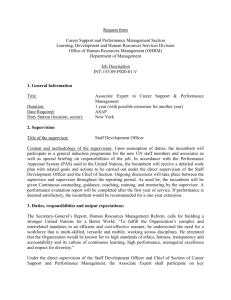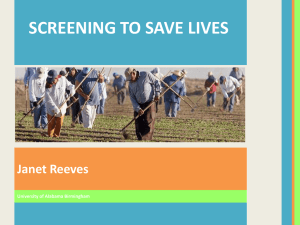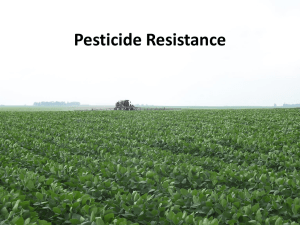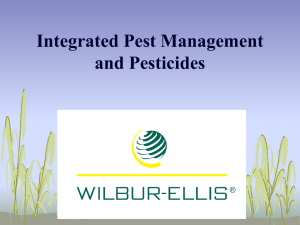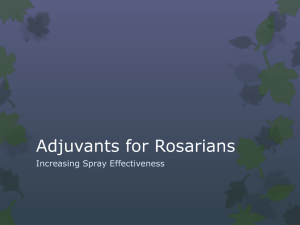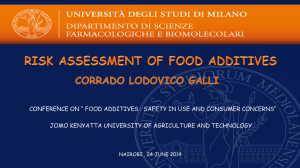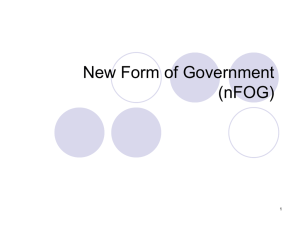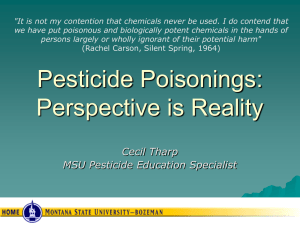384k ppt file - New York State Integrated Pest Management Program
advertisement
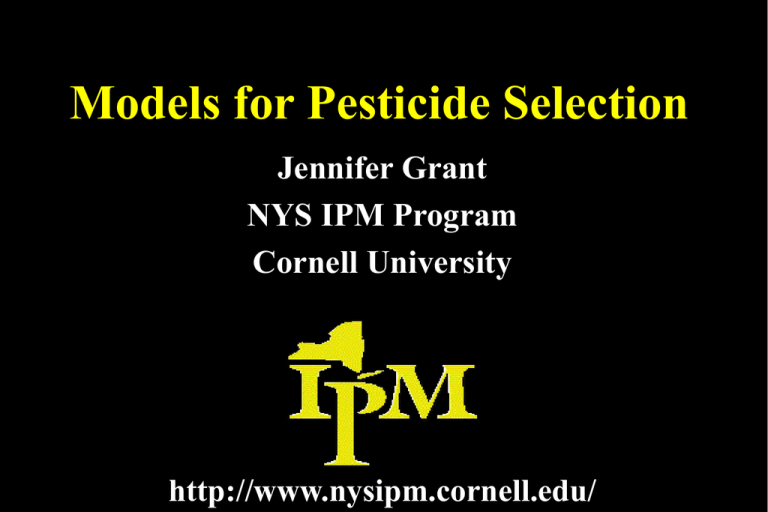
Models for Pesticide Selection
Jennifer Grant
NYS IPM Program
Cornell University
http://www.nysipm.cornell.edu/
Pesticide selection criteria:
the 3 E’s
• Efficacy
• Economics
• Environmental & health
impact
Data Sources
• MSDS Sheet
• Label
• Cornell Pesticide Management and
Education Program, PIMS site
• EPA pesticide fact sheets
• EXTOXNET pesticide summaries
• Pesticide Action Network (PAN) database
• Turf Pesticides and Cancer Risk Database
Water impact models for
Agriculture
Based on:
• Chemical and physical properties of
pesticides that affect environmental
fate (e.g. solubility, soil adsorption)
• Agricultural crops (row crops with
some bare soil)
• Physical properties of soils
Water impact models for
Agriculture
• WinPST (USDA National Resource
Conservation Service’s Windows Pesticide
Screening Tool)
• GLEAMS (Groundwater Loading Effects of
Agricultural Management)
• NAPRA (National Pesticide Risk Analysis)
• GUS (Groundwater Ubiquity Source)
• SPISP (Soil Pesticide Interaction Screening
Procedure)
Water impact models for
Turfgrass
• TurfPQ (model for runoff from turfgrass,
Haith, 2001)
– estimates pesticide in runoff events from turf
– Accounts for thatch
– Uses Carbon content, OM and bulk density
specific to turf
– Useful for water quality studies and
environmental assessments
Model Complexity
• Ecological impacts (e.g. toxicity to
fish, other non-targets)
• Human health impacts
• Site specificity (e.g. soil type, slope)
• Management influences
NRCS Three-Tiered Pesticide
Environmental Risk Screening
• Tier 1 - SPISP
• Tier 2 = NAPRA
–
–
–
–
Utilizes GLEAMS
environmental benefits of management alternatives
Regional climatic conditions
Results consider both the off-site movement of
pesticide and its toxicity to non-target species
• Tier 3 - NAPRA
– Site specific
– Generic inputs are replaced by individual producers'
filing records and field measured soils data
Integrated models for selection
Decision Tool for Integrated Pesticide
Selection and Management (IATP)
–
–
–
–
Minnesota corn & soybeans
Water contamination focus (WinPST)
Human exposure (drinking water)
Fish as non-target organism
Integrated models for selection
Environmental EIL
– Assigns an “environmental cost” to pest
management, based on opinion surveys
(contingent valuation)
– Largely theoretical, but assigns values
(Higley & Wintersteen, 1992)
Risk/Category and Environmental Cost,
Environmental EIL
Insecticide
Sur H2O
Grd
H2O
Orthene 75S
(acephate)
DiPel ES (Bt K)
LR
LR
LR
MR
NR
LR
LR
NR
D-z-n diazinon 4E
MR
MR
HR
HR
Insecticide
Orthene 75S
Aquatic Avian
Mammal Benef. Acute Chronic Total
Insects
"Cost"
LR
LR
LR
LR
$6.14
DiPel ES
NR
NR
NR
LR
$2.25
D-z-n diazinon 4E
LR
HR
LR
LR
$8.95
Integrated models for selection
Environmental Yardstick (Netherlands)
– Values risk as environmental impact points
– Based on
• Acute risk to water organisms
• Risk of groundwater contamination
• Acute and chronic risks to soil organisms
– Provides numerical value for a pesticide applied at a
specific rate
– Expressed as environmental impact points (EIP)
(www.agralin.nl/milieumeetlat; Reus and Pak, 1993; Reus and Leendertse, 2000)
Integrated models for selection
Environmental Yardstick (cont’d)
Currently used in the Netherlands
–
–
–
–
Farm & Greenhouse decision support tool
Environmental performance incentive
Standards for eco-labels
Policy tool
(www.agralin.nl/milieumeetlat; Reus and Pak, 1993; Reus and Leendertse, 2000)
Integrated models for selection
Environmental Impact Quotient (EIQ)
– Original model published in 1992 (Kovach
et al.) for food crops
– Three components: worker, consumer,
ecological
– Provides numerical value for a pesticide,
applied at a specific rate
– Can use to select pesticides or compare
systems
EIQ
=
{C x [DT x 5 + (DT x P)]
+
[(C x ((S + P)/2) x SY) + L]
+
[(F x R) + (D x ((S + P)/2) x 3) + (Z x P x 3) +
(B x P x 5)]}
÷3
EIQ
• Farm worker: Acute and chronic toxicity to
humans.
• Consumer: Food residues, chronic toxicity
to humans, leachability to groundwater.
• Ecological: Aquatic and terrestrial nontarget toxicity (fish, bees), leachability,
persistence.
EIQ
• Risk = toxicity x potential for exposure
• E.g. effect on fish depends on toxicity to
fish, and likelihood of fish encountering
pesticide.
– Persistence
– Surface loss potential
Farm worker Component
Applicator + Picker
(C * DT * 5) + (C * DT * P)
Dermal Toxicity
Chronic Toxicity
Plant surface residue half-life
Chronic Toxicity
• Average of Reproductive, Teratogenic,
Mutagenic, & Oncogenic effects
• Low value if no evidence of
carcinogenicity
• High value if probable human carcinogen
Dermal Toxicity
• Dermal LD50 rabbits
• Dermal LD50 rats
1 = > 2000 mg/kg
3 = 200 - 2000 mg/kg
5 = 0 - 200 mg/kg
Plant Surface Residue
1 = < 2 weeks
3 = 2-4 weeks
5 = > 4 weeks
Herbicides
Pre-emergent = 1
Post-emergent = 3
Consumer Component
Food residue + Groundwater
(C * ((S + P)/2) * SY)
+
(L)
Soil half-life
Plant half-life
Chronic Toxicity
Mode of Action:
Systemic or non
Leaching potential
Exposure
Persistence
• Plant half life
• Soil half life
Ecological Component
Fish + Bird + Bee + Beneficials
Each organism X potential for exposure
Ecological component
• Fish toxicity (F)
• Surface Loss
Potential (R)
• Bird Toxicity (D)
• Soil half life (S)
• Plant surface half life (P)
• Bee Toxicity (Z)
• Beneficial Arthropod
toxicity (B)
= [(F x R) + (D x ((S + P)/2) x 3) + (Z x P x 3)
+ (B x P x 5)]
Beneficial arthropod impact
• SELCTV database on 600 chemicals, 400
natural enemies (Oregon State Univ.,
Theiling and Croft, 1988)
• Data generated more recently -standardized on 5 natural enemies (insects)
and 3 microbials
– (Cornell, Petzoldt & Kovach, 2002)
EIQ
=
{C x [DT x 5 + (DT x P)]
+
[(C x ((S + P)/2) x SY) + L]
+
[(F x R) + (D x ((S + P)/2) x 3) + (Z x P x 3) + (B x P
x 5)]}
÷3
The poison is in the dose!
The poison is in the dose!
An EIQ value must be multiplied by the rate
it is applied. This yields a “field EIQ” that
can be compared.
EIQ as a Pesticide
Selection Tool
Insecticide Example
Worker Consumer
Cyf luthrin
Ecological
EIQ
Field EIQ
7
2
108
40
3
Chlorpyrif os
18
3
109
44
22
Et hoprop
69
7
105
62
311
Fungicide example
Bacillus
W orker
Consumer
Ecological
EIQ
Field EIQ
6
2
12
7
0.13 - 0.51
lichenif ormis
Iprodione
.25 DS
12
2
21
11
14-61
21-26 DS
Chlorot halonil
20
8
91
40
44 - 661
184 - 392 DS
Additional Considerations
•
•
•
•
•
Resistance management
Ease of application
Weather conditions
Availability of product
Availability of equipment
EIQ for Comparing
Management Strategies
Conventional Red Delicious
Material EIQ ai Apps Dosage Total
Nova
65.3 .4
4
0.3
31
Captan
16.2 .5
6
3.0
24
Lorsban
35.0 .4
1
1.5
21
Lorsban
35.0 .5
2
3.0
105
Thiodan
34.0 .5
1
3.0
51
Guthion
26.3 .35
2
1.5
14
Cygon
49.6 .43
3
2.0
128
Omite
27.5 .68
2
2.0
75
Sevin
21.7 .5
1
1.0
11
Kelthane 26.1 .35
1
4.5
41
Total field EIQ 501
IPM Strategy, Red Delicious Apples
Material EIQ ai Apps Dosage Total
Nova
Captan
Dipel
Sevin
Guthion
65.3
16.2
10.6
21.7
26.3
.4
.5
.06
.8
.35
4
1
3
1
2
.13
1.3
.73
1.1
.95
13.6
10.5
1.4
19.1
17.5
Total field EIQ 62.1
IPM Strategy, Liberty Apples
Material EIQ
Imidan
16.1
ai Apps Dosage Total
.5
3
1.5
36.2
Total field EIQ 36.2
Organic Strategy, Red Delicious Apples
Material EIQ
Sulfur
Rot/pyr
Ryania
ai Apps Dosage Total
26.4 .9
7
16.3 .04 6
10.6 .001 1
6
12
58
997
47
1
Total field EIQ 1045
SUMMARY
Strategy
Organic
Field EIQ
1045
Conventional
501
IPM
62
IPM on Liberty
36
Is the EIQ useful for Turf?
• Toxicity and environmental fate characteristics
of the pesticides are the same for ag. and turf
• The arrangement of these data in the formula
are similar to what would be appropriate for
turfgrass
• the EIQ and other quantitative models are the
best we can do until there is a model
specifically designed for turf
Environmental Impact of Pesticide Applications, Bethpage
Project, 2004, expressed as Field EIQ
Field EIQ (average per green)
6,000
2004
2005
RR A lt.
(velvet)
IPM Std.
5,000
4,000
3,000
2,000
1,000
0
RR A lt.
(poa/cb)
IPM A lt.
UNR Std.
UNR A lt.
(Grant & Rossi 2006)
EIQ Challenges
• Standardization of data & data
gaps
• Weighting may not meet criteria
of user
• Not site specific
Turfgrass EIQ
• Adjust formula to better reflect turfgrass
system
–
–
–
–
replace bee toxicity with earthworm toxicity
“User” for consumer (e.g. golfer)
Weight factors appropriately for turfgrass
Incorporate TurfPQ?
• Include site specific information such as
soil type and water proximity
Pesticide selection criteria:
the 3 E’s
• Efficacy
• Economics
• Environmental & health
impact
